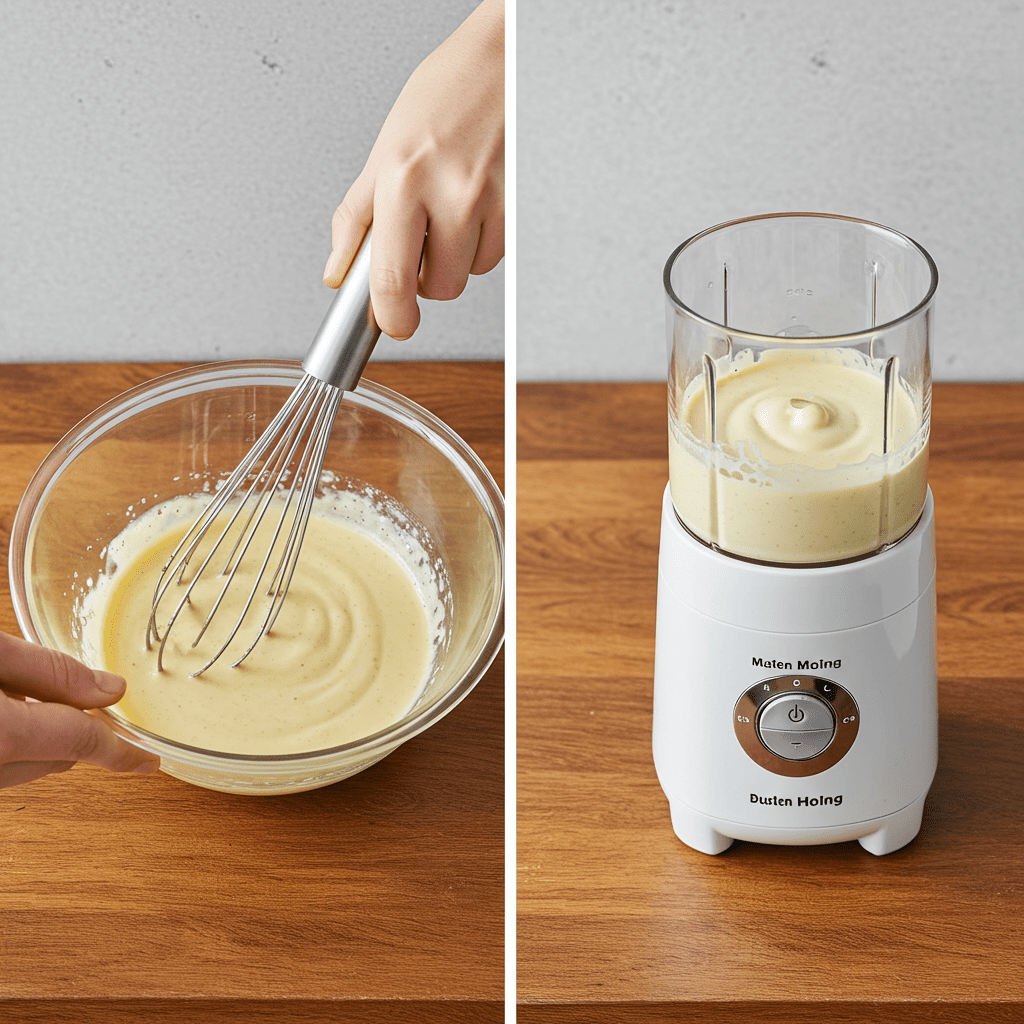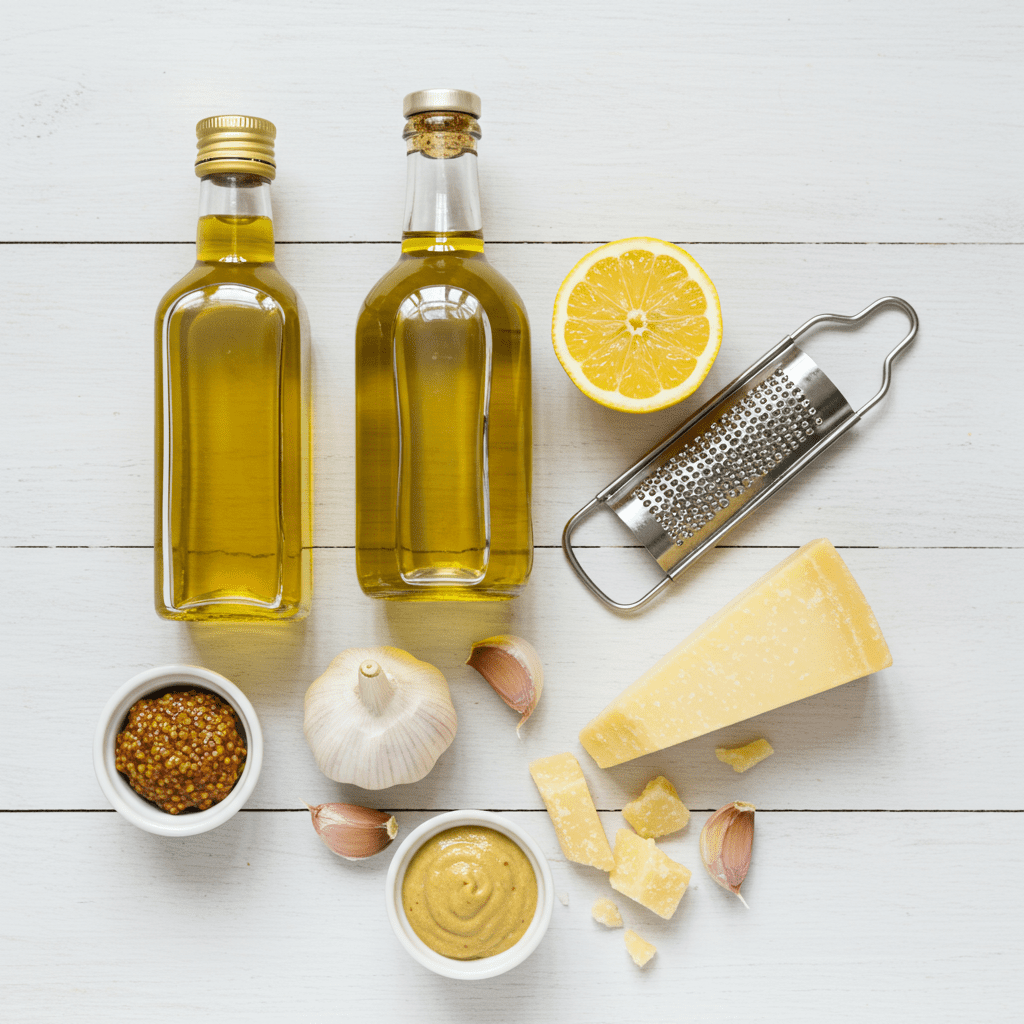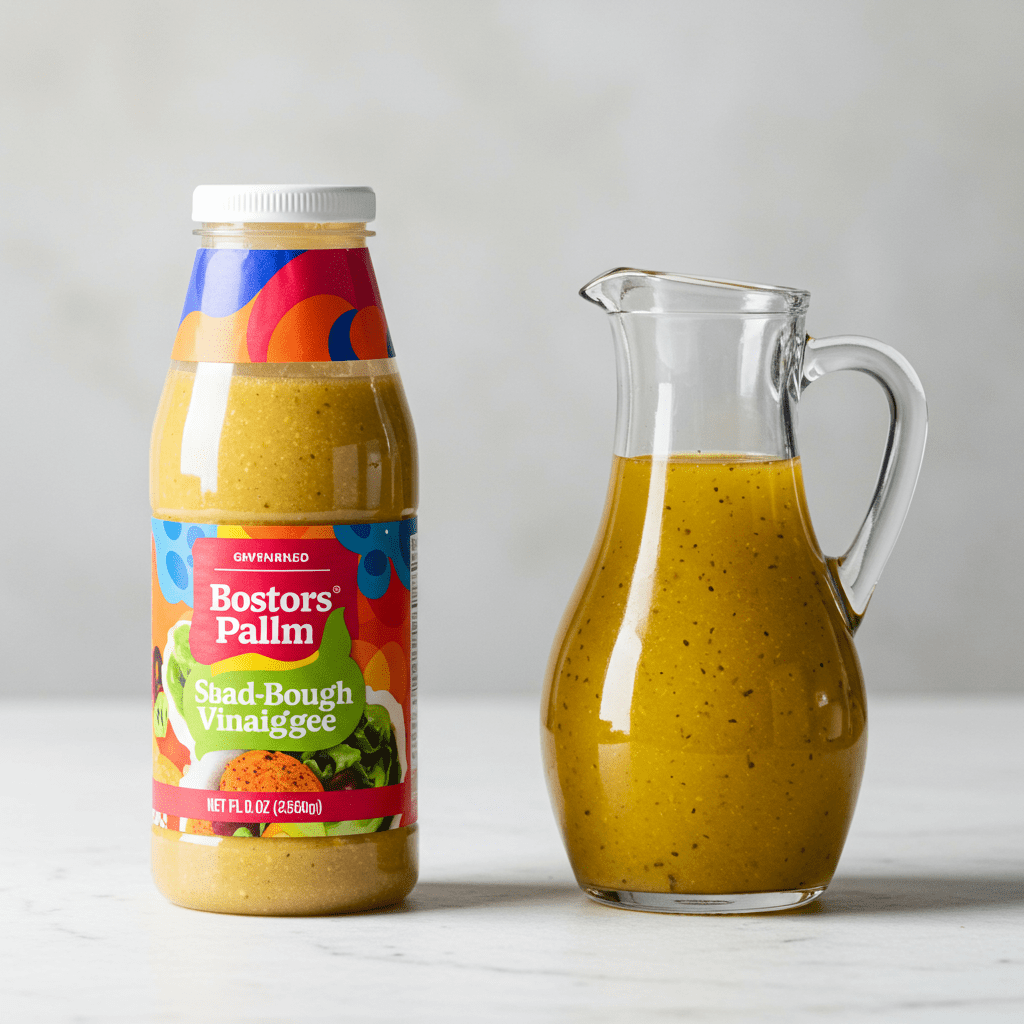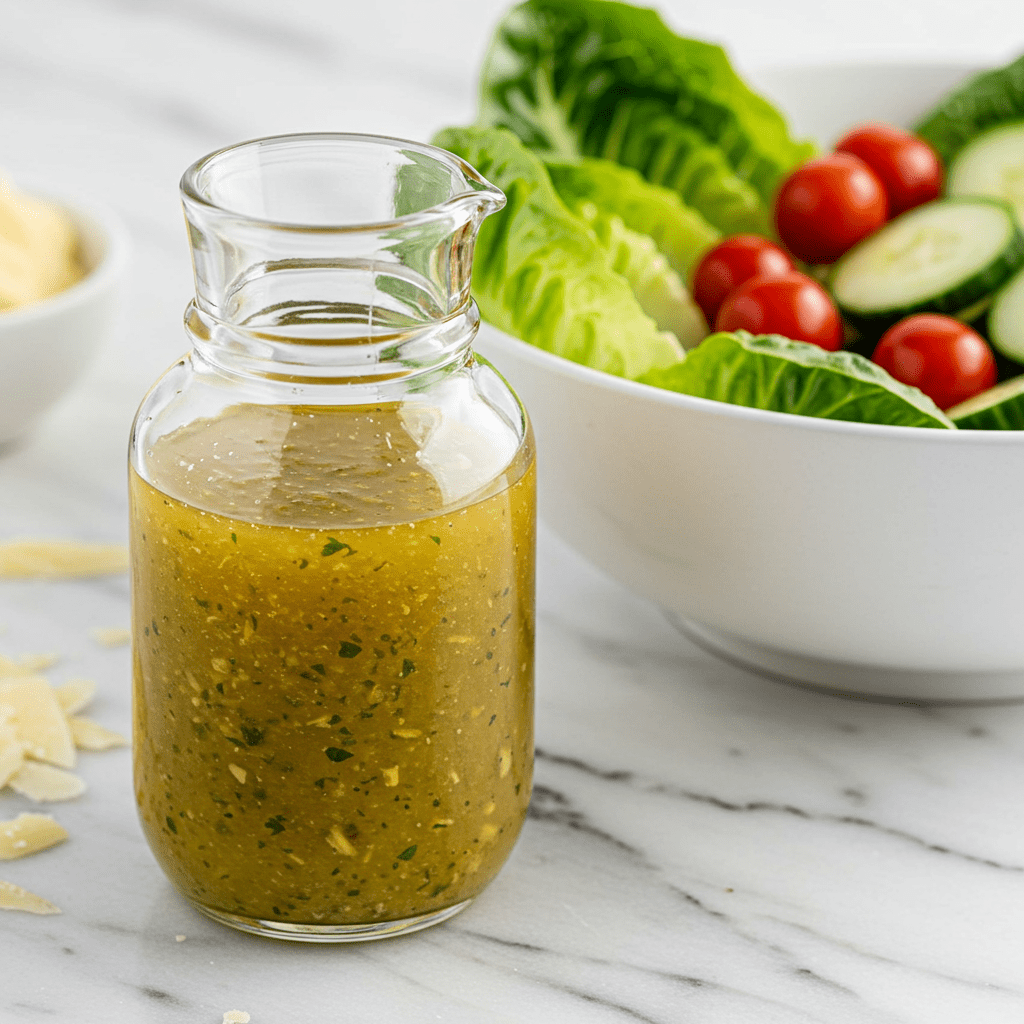Why This Garlic Parmesan Dressing Beats Store-Bought Every Time

Let’s be honest, a great dressing is what transforms a simple bowl of greens into a meal you actually crave. If you’re stuck in a salad rut, this homemade garlic parmesan dressing is your ticket out.
It’s incredibly simple to whip up, and the difference in flavor compared to a bottled dressing is astounding. As a registered dietitian, I love this recipe not just for its taste, but for the control it gives you over the ingredients—letting you pack in the good stuff without the unnecessary additives.
- What’s Really in Your Bottled Dressing?
- What Makes This Dressing So Good?
- How to Pick the Right Olive Oil
- The Simple Science of a Stable Dressing
- Let’s Make the Garlic Parmesan Dressing Step-by-Step
- So Is This Dressing Actually Healthy?
- How Can I Use This Besides on a Salad?
- How to Store Your Dressing for Freshness
- Easy Swaps and Delicious Variations
- Conclusion
What’s Really in Your Bottled Dressing?

Flipping over a bottle of store-bought dressing can be an eye-opening experience. Many are loaded with preservatives, added sugars, sodium, and unhealthy fats to make them shelf-stable and hyper-palatable.
By making your own, you replace ingredients like soybean oil, high-fructose corn syrup, and artificial flavors with fresh, whole-food components. You control the quality of the oil, the amount of salt, and the type of sweetener, leading to a fresher, more vibrant, and nutritionally superior dressing.
What Makes This Dressing So Good?

The magic of this dressing lies in its simplicity and the quality of its components. Each one plays a crucial role:
- Extra-Virgin Olive Oil: This is the heart of the dressing, providing a rich flavor and a dose of heart-healthy monounsaturated fats. Research from the Harvard T.H. Chan School of Public Health highlights these fats as beneficial for cardiovascular health.
- Fresh Lemon Juice: Adds brightness and a kick of Vitamin C, cutting through the richness of the oil and cheese.
- Real Parmesan Cheese: Provides a salty, umami depth and a bit of creaminess. Opt for a block of Parmigiano-Reggiano and grate it yourself for the best flavor and meltability.
- Fresh Garlic: The star of the show, offering a pungent, spicy bite. Garlic contains allicin, a compound studied for its potential immune-supporting and anti-inflammatory properties, as noted by the Cleveland Clinic.
- Dijon Mustard: This isn’t just for flavor. Dijon mustard is a powerful emulsifier that helps bind the oil and lemon juice together, creating a stable, cohesive dressing.
How to Pick the Right Olive Oil

Not all olive oils are created equal, and for a dressing, the choice matters. Always opt for Extra-Virgin Olive Oil (EVOO).
This is the least processed form, meaning it retains the most antioxidants and polyphenols. These compounds are responsible for many of its health benefits, including reducing inflammation.
When shopping, look for EVOO in a dark glass bottle, which protects it from light damage. The flavor can range from peppery and robust to mild and buttery, so feel free to experiment to find your favorite.
The Simple Science of a Stable Dressing

Ever wonder why your homemade dressing separates? It’s because oil and vinegar (or lemon juice) are natural enemies that don’t want to mix.
The solution is an emulsifier. In this recipe, the dijon mustard acts as the bridge.
Lecithin and other compounds in the mustard surround the tiny oil droplets, preventing them from clumping back together and keeping the dressing beautifully blended. For an even more stable and creamy emulsion, using a blender or food processor is key.
The high speed breaks the oil into minuscule droplets, creating a thicker, restaurant-quality dressing that clings perfectly to your salad greens.
Let’s Make the Garlic Parmesan Dressing Step-by-Step
Ingredients:
- 1/2 cup extra-virgin olive oil
- 1/3 cup fresh lemon juice (from about 1-2 lemons)
- 1/2 cup freshly grated Parmesan cheese
- 2-3 cloves garlic, minced or pressed
- 1 tablespoon honey or maple syrup
- 1 teaspoon Dijon mustard
- 1/2 teaspoon Italian seasoning (optional)
- 1/4 teaspoon sea salt
- 1/4 teaspoon black pepper
Instructions (Two Ways):
- By Hand (For a Classic Vinaigrette): In a medium bowl, whisk together the lemon juice, garlic, honey, Dijon mustard, salt, and pepper. While whisking continuously, slowly stream in the olive oil until the dressing is emulsified. Stir in the Parmesan cheese.
- With a Blender (For a Creamier Dressing): Combine all ingredients in a blender or the cup of an immersion blender. Blend on high for 30-45 seconds, or until the dressing is smooth, creamy, and pale yellow. This is my preferred method for a no-fail, super-stable dressing.
So Is This Dressing Actually Healthy?
As a dietitian, I give this dressing a big thumbs-up, especially when compared to store-bought alternatives. The primary ingredient is olive oil, a cornerstone of the heart-healthy Mediterranean diet.
According to the American Heart Association, replacing saturated fats with unsaturated fats like those in olive oil can help lower bad cholesterol levels. The fresh garlic and lemon juice contribute vitamins and antioxidants with minimal calories.
While it does contain fat and sodium from the oil and cheese, these are part of a whole-food matrix. The key is portion control.
A 1-2 tablespoon serving is all you need to add a massive flavor boost and healthy fats to your meal.
How Can I Use This Besides on a Salad?
Think of this dressing as an all-purpose flavor booster! Its uses go far beyond the salad bowl:
- Marinade: It’s fantastic for marinating chicken, fish, or pork before grilling or baking.
- Vegetable Drizzle: Toss it with roasted or grilled vegetables like asparagus, broccoli, or zucchini right after they come out of the oven.
- Pasta Salad Sauce: Use it as the base for a vibrant and zesty pasta salad.
- Sandwich Spread: Mix it with a little Greek yogurt or mayo for a delicious spread for sandwiches and wraps.
- Dip: Serve it as a dip for fresh-cut veggies, crusty bread, or even pizza crusts.
How to Store Your Dressing for Freshness
Store your homemade dressing in an airtight container, like a mason jar, in the refrigerator for up to one week. Don’t be alarmed if it solidifies or separates in the cold—this is a natural characteristic of good-quality olive oil.
To use, simply let it sit on the counter for 10-15 minutes to liquefy, then give it a vigorous shake to re-emulsify everything before serving. It will be as good as new!
Easy Swaps and Delicious Variations
This recipe is a great starting point. Feel free to customize it to your liking:
- Make it Creamy: Add 2 tablespoons of plain Greek yogurt or a spoonful of tahini before blending.
- Add Fresh Herbs: Finely chopped parsley, chives, or basil add another layer of freshness.
- Give it a Kick: A pinch of red pepper flakes will add a welcome warmth.
- Change the Acid: Swap the lemon juice for white wine vinegar or red wine vinegar for a different tangy profile.
- Go Nut-Free: If you need to avoid nuts (Parmesan can be an issue for some allergies), you can substitute it with a similar amount of nutritional yeast for a cheesy, umami flavor.
Conclusion
Making your own garlic parmesan dressing is one of the easiest and most rewarding kitchen upgrades you can make. In just five minutes, you can create a delicious, healthy, and versatile dressing that elevates everything it touches.
Say goodbye to boring salads and hello to a world of fresh, vibrant flavor that you can feel good about.
